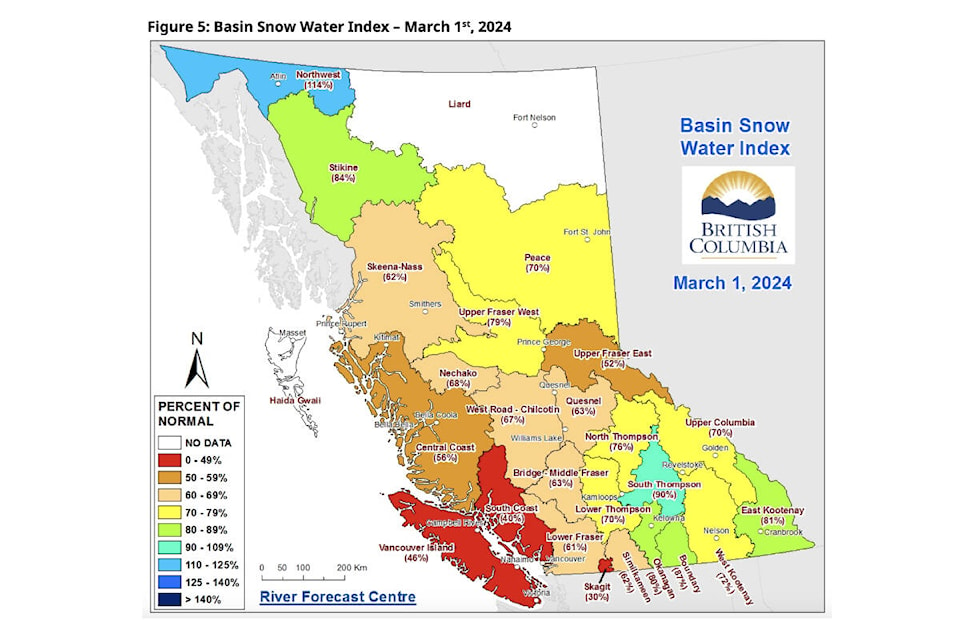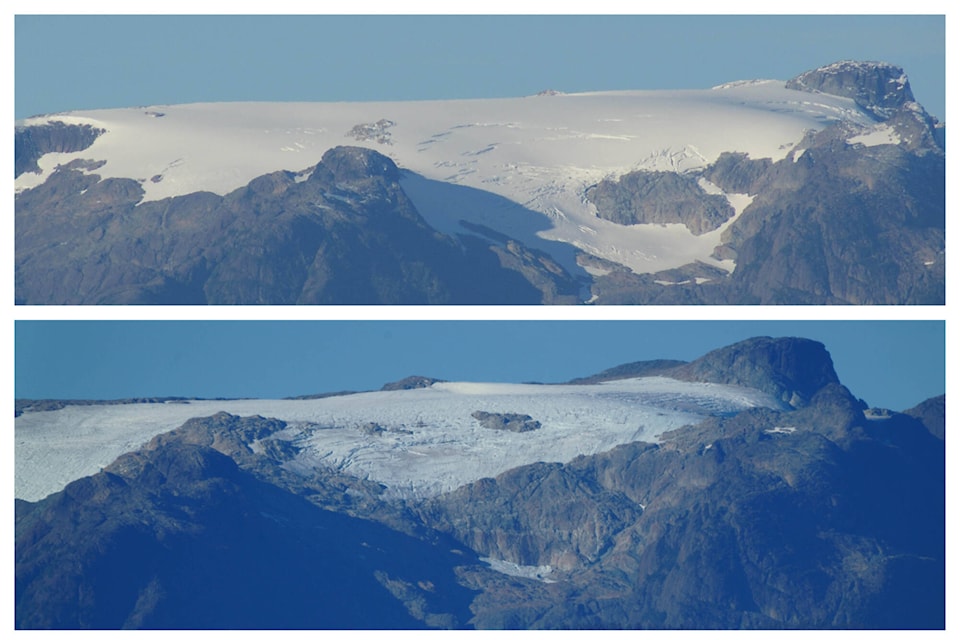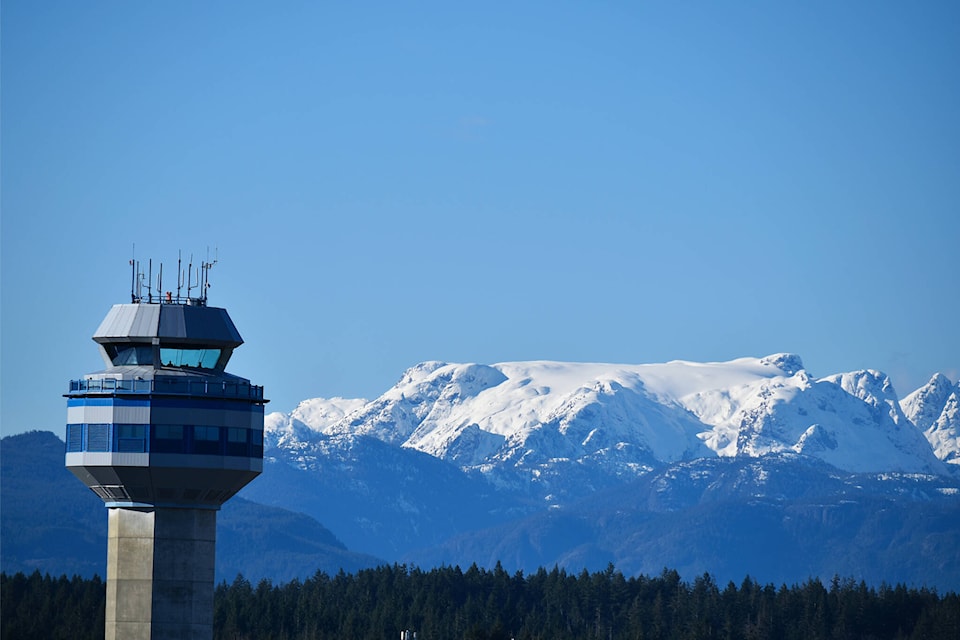The province’s near-record low snowpacks could have devastating impacts on the environment.
B.C.’s current snowpack is tied for the second-lowest March 1 levels at 34 per cent below average — the lowest it’s been in more than 20 years.

Among the hardest-hit regions is Vancouver Island, behind the South Coast (60 per cent) and Skagit (70 per cent), with a snowpack at 54 per cent below average.
This trend concerns Comox Valley resident Fred Fern, a former logger and local conservationist, who has been documenting the receding of the Comox Glacier over the past decade.

“I guess the photos tell the story. The glacier is beautiful to look at, but it’s a canary (in the coal mine),” said Fern. “It has probably been melting for the last 80 years, but it was stable for probably 12,000 years before that.”
As a keen observer of Mother Nature’s ways, Fern noted that a few decades ago, the snowline around the Valley would typically begin at the 800-metre mark. However, he has noticed this line increasing in elevation over time.
“(For most of the winter) Mount Washington barely (had) two feet of snow,” Fern said. “I’m not a scientist, but I’m just worried because these changes in the last 50 years (have been) incredible.”
Scientific data support Fern’s concerns.
A report published by the B.C. government found that the Georgia Depression, which encompasses the western part of Vancouver Island, has seen a consistent snow depth decrease of six percent per decade since 1950.
While climate change may be a primary factor contributing to this situation, registered biologist Rupert Wong noted the presence of a recurring meteorological phenomenon influencing this year’s snow condition.
“This is not unusual and it’s kind of cyclical. This is what (meteorologists) call an El Niño year,” Wong said. “Things were expected to be quite sparse in terms of precipitation and snowfall at elevation.”
El Niño conditions are characterized by warmer Pacific water temperatures which warm the air and lead to spring-like winter weather.
However, the biologist noted that the province is still at a deficit when it comes to overall precipitation, highlighting that most of the snow season is behind us.
This could become problematic when the warmer summer months come around.
“The gradually melting snowpack supplies a regular (source) of water that recharges aquifers, streams, lakes, and wetlands,” Wong said. “(However,) if the region’s water table isn’t recharged adequately, everything gets super dry and you have a higher fire risk.”
The biologist remains concerned about the rate at which these extreme weather events happen.
“We’ve had a series of bad fire years recently (and I’m wondering) just how much can our forest ecosystem take,” Wong added. “These wildfires do play a role in hitting the reset button and generating important nutrient profiles in the soil, but are they meant to happen at this kind of frequency? I don’t think so.”
Low snowpack levels can also add stress to B.C.’s power grid, which relies on hydroelectricity for 86 per cent of its energy. Powerhouses across the province depend on snowmelts and glacier runoffs responsible for feeding their reservoirs.
BC Hydro spokesperson Ted Olynyk stays confident that customers would not feel the impact of this year’s conditions.
“It’s a concern period now with snowpack levels being what they are, but we manage our system such that BC Hydro can ensure and meet the needs of our customers,” said Olynyk.
If a region were to struggle to supply power to its population, BC Hydro has multiple options available.
“We’re all part of a larger grid,” Olynyk said. “There are three dams in the Campbell River and we have the Ash River (dam) in Port Alberni. We (also) have cables that connect us to the mainland, so we have sufficient resources throughout the province.”
On a positive note, Dave Campbell, head of the River Forecast Centre, told Black Press Media that the current situation may have a silver lining.
“With the lower-than-normal snowpack, we are anticipating a decrease in the seasonal flood risk in most areas of the province,” he said.
Potential impacts on B.C.’s fauna
Without enough snowmelts to recharge the region’s headwaters, the biologist is worried that salmon-bearing streams might become a death trap for newborn fish.
“In the summertime, there’s a thing called ‘dewatering.’ (It happens) when a river’s base flow starts to diminish,” said Wong. “You get pools where salmon get isolated and (other areas) completely dry out. Where water is becoming stagnant, temperatures are going up (and enter an) anoxic state where oxygen levels diminish and salmon start to get stressed. They can develop some problems or perhaps even die.”
Lower water levels can also endanger the survival of salmon in the final stage of their lives, as they need to swim upstream at the beginning of the spawning season.
“When the water levels come up (salmon) know it’s time to go because they can get through obstacles (in the river,)” he said. “But when there are no rainfalls, and the water tables are depleted, fish are being held up in the estuary (where they are) getting picked off by predators and poachers.”
This could have a “fairly devastating impact” on overall biodiversity, according to Wong. A single year of poor spawning due to extensive droughts could result in the loss of a generation of this keystone species.
Consequently, poor salmon returns in the following years could lead to increased hunger for countless animals depending on them for survival.
“Salmon (feed the entire) food chain and there’s definitely going to be a ripple effect on the megafauna,” said Wong. “(That includes) grizzly bears, orcas, sea lions, wolves, birds (and more.)”
Although Wong remains optimistic, believing that “nature is quite resilient and can recover” from traumatic events, he expressed concerns about the role of human activities in potentially worsening the current situation.
“My concern is: are we giving our systems enough time to recover? Will our forest and river ecosystems recover quickly enough?” Wong wondered. “The cumulative effects of various stressors, whether they’re weather-related or caused by human activities, I think we need to adapt our resource management strategies.
“We, as a community, need to look at this kind of new weather regime and make some adaptations to how we manage our resources.”
- With files from Lauren Collins
RELATED: B.C.’s snowpack is 39% below normal levels
NEWSLETTER: Sign up for local news updates to your email
